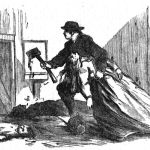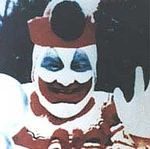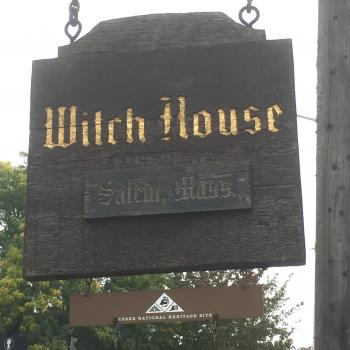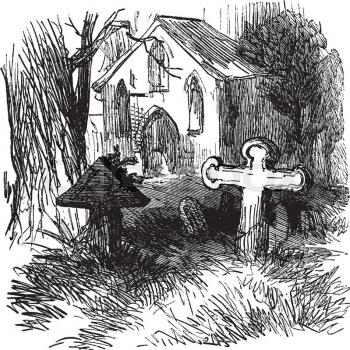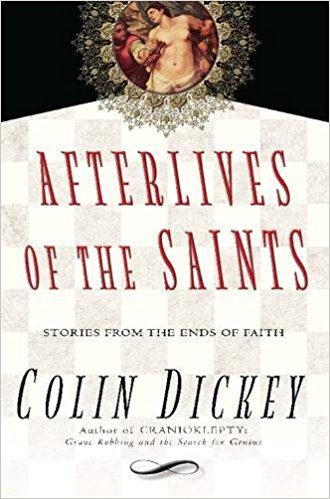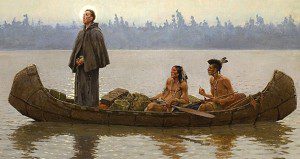
For my birthday this year a friend benevolently kidnapped me and took me on a road trip further up and further in to Northern Lower Michigan. We drove the Tunnel of Trees and window shopped in posh Harbor Springs, which I’ve heard called the Hamptons of the Midwest. In the middle of town stands the old French Jesuit church, now called Holy Childhood of Jesus. Inside, there’s a mural depicting a Jesuit and a Franciscan, the two orders that established Catholic missions here in the 1800s. Along the scenic drive through the picturesque north woods, I found the marker for L’Arbre Croche, the Crooked Tree, which was what the Native Americans called the area.
In 1847, L’Arbre Croche had the largest concentration of Native Americans in Michigan; the Little Traverse Bay Bands of Odawa Indians are descendants of the historical Odawa bands that originally lived here. The Jesuit mission was built in 1840 by Father Pierre DeJean, who took charge of the growing number of Catholic converts.
When I got home from, I discovered on my own bookshelf–like something out of a Machen tale–an old crumbling copy of The Crooked Tree: Indian Legends of Northern Michigan by John C. Wright. I must have picked it up at a thrift shop when we first moved here and then forgotten it.
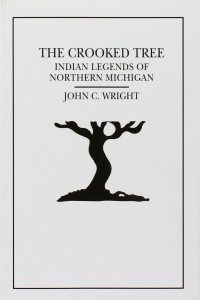 The Crooked Tree is a collection of stories handed down by the Wright’s Odawa grandmother, including oral histories of how the natives lost their land in bad deals with the US government, creation myths like the origin of the Sleeping Bear islands, and weather folklore about Old Man Winter and the changing seasons. Wright also relates some of the “many feats of magic performed by the Indians of L’Arbor Croche,” feats “witnessed many times by white people, and a committee of citizens appointed to investigate the matter at Mackinac Island in 1847 reported that it could find no fraud in the exhibition and therefore it must be the result of some genuine Indian magic or witchcraft.” The Christians assumed that such feats were “the work of the devil.” The author doesn’t comment; he merely relates the tales as one would sitting around the campfire late at night.
The Crooked Tree is a collection of stories handed down by the Wright’s Odawa grandmother, including oral histories of how the natives lost their land in bad deals with the US government, creation myths like the origin of the Sleeping Bear islands, and weather folklore about Old Man Winter and the changing seasons. Wright also relates some of the “many feats of magic performed by the Indians of L’Arbor Croche,” feats “witnessed many times by white people, and a committee of citizens appointed to investigate the matter at Mackinac Island in 1847 reported that it could find no fraud in the exhibition and therefore it must be the result of some genuine Indian magic or witchcraft.” The Christians assumed that such feats were “the work of the devil.” The author doesn’t comment; he merely relates the tales as one would sitting around the campfire late at night.
He describes “lodge shaking”:
The performer, usually an old man, would seat himself in the center of a little wigwam, which was raised from the ground on all sides so that the spectators could see that no one touched it in any way. He would begin chanting and drumming…first slowly, then faster and faster, and finally the tent would commence to sway back and forth, increasing its speed with the music, until it seemed like an animate object. It would shake violently and sometimes the top would nearly touch the ground in its action.
And “going in fire”:
It had to be performed at night time and great precautions were made for it. The magacian [sic] would assume the form and don the mask of some animal, such as a bear, a wolf or a fox, and anoint his body with oils and extracts. Then starting on a run, he was said to go like the wind and become invisible, except, at intervals, when he would emit a bright light…It is hard to account for this strange illusion, except on the theory that the liquids with which the body was anointed were of such a nature that they produced a sort of phosphorescent light as the person traveled along…Nevertheless, whenever an Indian spoke of ‘going in fire’ it was with abated breath…”
Those who claimed to have been visited by this spectacle “would grow pale and ghastly at the thought, enduring all manner of mental torture and anguish.”
Of course, our Jesuit missionaries “deplored these practices,” but the customs continued as late as 1865.
I wonder what they made of Father Wiekamp, a tertiary Franciscan who established a convent in Cross Village. According to Wright, Father Wiekamp was “a very odd and eccentric character,” who, in addition to his convent, erected a white tomb “which he kept in readiness to receive his remains.” Fair enough. But it gets weirder.
The tomb consisted of a deep cellar covered by a small wooden building, and though it was always kept locked, there was known to be a casket inside, “surmounted by a skull and cross bones, beside which the priest daily made three hours of meditation, with strict orders that he should not be disturbed.” He also went there to read and enjoy after-dinner smokes. Some claimed it was filled with “casks of choice wine.” So yeah–it sounds like Father Wiekamp had a man cave.
Years passed, and the aging Father Wiekamp sustained some serious injuries when a startled horse threw him. A friend, hearing of his illness, hastened to the village to be at his deathbed. To his surprise, he found the monk alive and well in his tomb:
As I neared the little building, I could distinctly hear Father Wiekamp’s voice alternately singing and praying. The door was flung wide open and looking in I beheld him on his knees as I had seen him many times before. I could not have been mistaken–I was too well acquainted with that short, rotund figure, and full red face surmounted by a fringe of white. I, of course, concluded that he had recovered from his illness and not wishing to disturb him, quietly withdrew to the convent.
When the sisters opened the door, the man expressed his relief that the good father had recovered, only to hear that he’d been laid to rest in his tomb the day before.
They rushed to the tomb but found it dark, securely locked, with no sign of any living thing within. They opened the door and found “all was still as death.”
We opened the casket to more thoroughly convince ourselves regarding the matter, and beheld the familiar features of the dead tertiary, whose body was in precisely the same position in which it had been placed the day before by the members of the Benevolent, Charitable and Religious Society of St. Francis.

